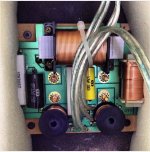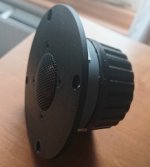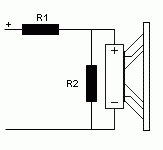Hi my first post so please be kind 😱
First a bit of background about me: I've built my own speakers in the past, but nothing advanced or complex. I essentially bought an off the shelf cross over and carefully chose tweeters and mid bass (all SEAS units) of the same stated SPL levels. Wired them all up and put them in a box that i built (having used the t/s parameters of the mid bass to design the box). So I've never done anything complex with crossovers hence my question here.
I have a pair of second hand Monitor Audio GR20 speakers, which are at least 15 years old I believe. These:

This is the measured (from here SoundStage! Measurements - Monitor Audio Gold Reference 10 Loudspeakers (10/2001)) listenting window frequency response of the GR10 which uses the same mid and tweeter (though obviously will have more bass weight and extension):
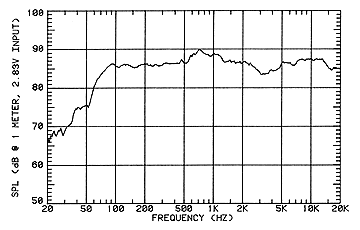
I've never been quite happy with the treble performance. Difficult to describe but overall it was qualitatively uneven (cymbals and guitars just didn't sound quite right). Oddly even though the graph above doesn't seem to show it the top end was just too loud overall (i ended up using the speaker grills which helped but led to other compromises), though of course that may be due to the room.
So having done a bit of reasearch and finding that MA use modified SEAS tweeters (attached is a picture of the old units) i decided to take a bit of a risk and get some replacement tweeters from SEAS. (having used SEAS units in the past I felt i at least knew they wouldn't be bad units). The units I chose are the 27TBFC/G. As i had no idea what the SPL of the existing units were I was expecting to have to pad them down as I thought it was unlikely that the exiting units had a higher sensitivity. But I decided just to swap them out first and see what i was left with. I was surprised that my first reaction was "they sound dull". As it happens it would seem like (purely from listening) that actualy the overal vocal range and mids are just much better balanced and the new tweeters are actually overall better integrated (again purely from listening) than the old ones.
Anyway to finally get to why I'm here (sorry for the long preamble). After a few days adjusting to the new balance I feel like the new tweeters could do with a tiny bit of a drop. The lower treble (going to guess the 3-5k region) feels just a touch too hot, (clearly i was expecting this region to be hotter as i expected the new tweeters to fill out the the suckout the old tweeters had, but it's gone just a touch too far). So i'd like to try padding down the tweeters by just 1db to see how they sound. I've measured the DC resistance of the old and new tweeters at 5.3 ohms, (about .5 ohm higher than SEAS state for the new tweeters, and presumably the old, but i'm going to put that down to my mulitmeters accuracy - it seems very sensitive to how the probes are positioned). According to MA the cross over is 2.7khz.
Attached is a picture of the exitsing crossover that i've managed to find. Going purely by a thread on this forum about the GS20 crossover, (here: Please help for Monitor Audio GS20 crossover tuning), I'm guessing the current one is a 2nd order HF (with a 3.3 Ohm resistor in series before the filter ciruit), first order mid (with notch filter) and first order bass.
So finally to my question 😱: As i don't want to mess around with cutting and soldering any of the existing wiring (and defintely not going to pull the speaker apart to start changing the original cross over) I was thinking of trying just a shunt resistor in parallel with the new tweeter to pad it down.
a) would this work?
b) what value resistor will i need to use to achieve a 1db drop? (according to the SEAS specs impedance runs 5 to 7 ohms between 2khz and 20khz on the new tweeters). I'd like to minimise any top octave drop in level/shelving of the response as much as possible. I'm thinking somewhere between 30 and 40 ohms?
Anyway goal is to drop the overall tweeter level by just 1db at this time, preferably using just a parrallel resistor, which I could solder on the existing wiring tags (thus avoiding having to put a soldering iron anywhere near the new tweeters).
I have no means to measure the speakers, and in all honesty I don't really want to get caught up in the effort all of that would entail. The speakers sound much better than they did previously, I'd just like to bring down the overall level of the tweeters a touch as i think they'd sound a bit better still if i did.
First a bit of background about me: I've built my own speakers in the past, but nothing advanced or complex. I essentially bought an off the shelf cross over and carefully chose tweeters and mid bass (all SEAS units) of the same stated SPL levels. Wired them all up and put them in a box that i built (having used the t/s parameters of the mid bass to design the box). So I've never done anything complex with crossovers hence my question here.
I have a pair of second hand Monitor Audio GR20 speakers, which are at least 15 years old I believe. These:

This is the measured (from here SoundStage! Measurements - Monitor Audio Gold Reference 10 Loudspeakers (10/2001)) listenting window frequency response of the GR10 which uses the same mid and tweeter (though obviously will have more bass weight and extension):

I've never been quite happy with the treble performance. Difficult to describe but overall it was qualitatively uneven (cymbals and guitars just didn't sound quite right). Oddly even though the graph above doesn't seem to show it the top end was just too loud overall (i ended up using the speaker grills which helped but led to other compromises), though of course that may be due to the room.
So having done a bit of reasearch and finding that MA use modified SEAS tweeters (attached is a picture of the old units) i decided to take a bit of a risk and get some replacement tweeters from SEAS. (having used SEAS units in the past I felt i at least knew they wouldn't be bad units). The units I chose are the 27TBFC/G. As i had no idea what the SPL of the existing units were I was expecting to have to pad them down as I thought it was unlikely that the exiting units had a higher sensitivity. But I decided just to swap them out first and see what i was left with. I was surprised that my first reaction was "they sound dull". As it happens it would seem like (purely from listening) that actualy the overal vocal range and mids are just much better balanced and the new tweeters are actually overall better integrated (again purely from listening) than the old ones.
Anyway to finally get to why I'm here (sorry for the long preamble). After a few days adjusting to the new balance I feel like the new tweeters could do with a tiny bit of a drop. The lower treble (going to guess the 3-5k region) feels just a touch too hot, (clearly i was expecting this region to be hotter as i expected the new tweeters to fill out the the suckout the old tweeters had, but it's gone just a touch too far). So i'd like to try padding down the tweeters by just 1db to see how they sound. I've measured the DC resistance of the old and new tweeters at 5.3 ohms, (about .5 ohm higher than SEAS state for the new tweeters, and presumably the old, but i'm going to put that down to my mulitmeters accuracy - it seems very sensitive to how the probes are positioned). According to MA the cross over is 2.7khz.
Attached is a picture of the exitsing crossover that i've managed to find. Going purely by a thread on this forum about the GS20 crossover, (here: Please help for Monitor Audio GS20 crossover tuning), I'm guessing the current one is a 2nd order HF (with a 3.3 Ohm resistor in series before the filter ciruit), first order mid (with notch filter) and first order bass.
So finally to my question 😱: As i don't want to mess around with cutting and soldering any of the existing wiring (and defintely not going to pull the speaker apart to start changing the original cross over) I was thinking of trying just a shunt resistor in parallel with the new tweeter to pad it down.
a) would this work?
b) what value resistor will i need to use to achieve a 1db drop? (according to the SEAS specs impedance runs 5 to 7 ohms between 2khz and 20khz on the new tweeters). I'd like to minimise any top octave drop in level/shelving of the response as much as possible. I'm thinking somewhere between 30 and 40 ohms?
Anyway goal is to drop the overall tweeter level by just 1db at this time, preferably using just a parrallel resistor, which I could solder on the existing wiring tags (thus avoiding having to put a soldering iron anywhere near the new tweeters).
I have no means to measure the speakers, and in all honesty I don't really want to get caught up in the effort all of that would entail. The speakers sound much better than they did previously, I'd just like to bring down the overall level of the tweeters a touch as i think they'd sound a bit better still if i did.
Attachments
Last edited:
Specs of 27TBFC/G is nominal impedance 6 ohms.
For 1dB attenuation you need R1 0,65 ohms & R2 49,17 ohms.
For 1dB attenuation you need R1 0,65 ohms & R2 49,17 ohms.
Attachments
Last edited:
Thanks for the reply but i'm specifically looking NOT to use an L-
pad, just a shunt resistor in parallel with the tweeter.
pad, just a shunt resistor in parallel with the tweeter.
R1 0.73 ohms. The closest match is 1 ohms parallelled with 2.7 ohms at only -0.04 % out.
Last edited:
That crossover (for the GS20) is not the same as your crossover (for the GR20).Attached is a picture of the exitsing crossover that i've managed to find.
I've done a quick search, but haven't found a crossover schematic for the GR20.
Merlin is right in his first post, the correct and safe way to attenuate your tweeter is to place a series resistor in the wire going to the positive tweeter connector and a parallel resistor across the two tweeter connectors.
For approximately 1dB of attenuation, I would simply use a series resistor of standard value 1.0 ohm and a parallel resistor of standard value 47 ohm (both 5W or 10W ceramic resistors).
Last edited:
Re measured the Tweeter DC resistance
Just an update;
I remeasured all the drive units as I wasn't confident on the values I'd got first time (i was in too much of a rush to swap in the new ones), and I'm happy to say that all 4 (both old and new tweeters) are measuring 5.3 ohms DC. So my faith in SEAS quality is restored and more importantly I can stop worrying about any possible change in cross over frequency caused by the new tweeters 🙂
Just an update;
I remeasured all the drive units as I wasn't confident on the values I'd got first time (i was in too much of a rush to swap in the new ones), and I'm happy to say that all 4 (both old and new tweeters) are measuring 5.3 ohms DC. So my faith in SEAS quality is restored and more importantly I can stop worrying about any possible change in cross over frequency caused by the new tweeters 🙂
You are into a lot more effort now. Even downloading a simple app like Speaker Meter and using your phone as a mike gives you more clues than the unreliable and tedious approach you're on now.I have no means to measure the speakers, and in all honesty I don't really want to get caught up in the effort all of that would entail.
That crossover (for the GS20) is not the same as your crossover (for the GR20).
I've done a quick search, but haven't found a crossover schematic for the GR20.
Thanks. I understand it's not identical, but i was going on the presumption that since the GS is an evolution/update of the GR that the philosophy of the two crossovers would be the same (and basically just tweaked). What Hi-Fi reviewed them both and basically said the GS was a more refined version of the GR wtih the "rough edges" removed. Ironically they prefered the GR. On that basis I presumed that the two crossovers would be very similar. Excluding differences in values the GS has a second order mid circuit. But the GR crossover (if in fact it actually is from a GR) is missing the extra inductor that would be needed to have a second order mid, and i'm also presuming there is no way MA would put a second order filter on the bass or mid and not the tweeter. Anyway that's the logic for why i thought the crossover is as I guessed.
Merlin is right in his first post, the correct and safe way to attenuate your tweeter is to place a series resistor in the wire going to the positive tweeter connector and a parallel resistor across the two tweeter connectors.
For approximately 1dB of attenuation, I would simply use a series resistor of standard value 1.0 ohm and a parallel resistor of standard value 47 ohm (both 5W or 10W ceramic resistors).
Thanks. I have ordered 4x 1 ohm and 2x 47 ohm resistors (10/11w wirewound ceramic). I'm going to try using two 1 ohms in parallel to give me a 0.5 ohm series resistance to use wtih the 47 ohm in parallel to the tweeter. Your suggestion gives a bit more attenuation than i want to achieve. This way I also have the option to try the 1 and 47 after if 0.5 and 47 is too subtle. 😱
I get your point, but ultimately in my opinion it's how the speakers sound in the room they're being used that matters. So whilst the engieering geek in me would love perfectly accurate speakers, at the end of the day if they end up sounding unbalanced on the end of my system (perfectly possible as rooms have a huge effect on the way speakers sound, even through the mids and treble regions) then what's the point?
However, thanks for the suggestion. I will download the app and see what the result is (I already have some frequency sweep wav files on my computer I can use). I doubt i'll put much belief in the results though as I highly doubt the mic in a smartphone is going to be anywhere near flat (it's only expected to record human voice and pass the sound over the telecommunications system which is bandwidth limited - 300hz to 3.4khz).
However, thanks for the suggestion. I will download the app and see what the result is (I already have some frequency sweep wav files on my computer I can use). I doubt i'll put much belief in the results though as I highly doubt the mic in a smartphone is going to be anywhere near flat (it's only expected to record human voice and pass the sound over the telecommunications system which is bandwidth limited - 300hz to 3.4khz).
It certainly is not flat. But it can do a job when comparing different setups. And you always could upgrade with a Dayton mic.
I didn't mention there are other fine apps around, like the Audiotools suite, the Etani RTA or SpectrumView
I didn't mention there are other fine apps around, like the Audiotools suite, the Etani RTA or SpectrumView
I don't understand if you have the factory crossover for your speaker or not. Please clarify.
As for the tweeter attenuation, I'd simply put a resistor is series before the crossover, buy some resistors in the 1-5 Ohm range and try what you like the best. Easiest method and in this way you'll also slightly tilt the tweeter response (less attenuation at higher frequencies).
As a side note, impedance is not equal to the DC resistance, as the latter is the resistance of the voice coil, and the impedance is a function of the frequency, that can be different at the crossover point even for two tweeters that have the same resistance.
Ralf
As for the tweeter attenuation, I'd simply put a resistor is series before the crossover, buy some resistors in the 1-5 Ohm range and try what you like the best. Easiest method and in this way you'll also slightly tilt the tweeter response (less attenuation at higher frequencies).
As a side note, impedance is not equal to the DC resistance, as the latter is the resistance of the voice coil, and the impedance is a function of the frequency, that can be different at the crossover point even for two tweeters that have the same resistance.
Ralf
I don't understand if you have the factory crossover for your speaker or not. Please clarify.
As for the tweeter attenuation, I'd simply put a resistor is series before the crossover, buy some resistors in the 1-5 Ohm range and try what you like the best. Easiest method and in this way you'll also slightly tilt the tweeter response (less attenuation at higher frequencies).
As a side note, impedance is not equal to the DC resistance, as the latter is the resistance of the voice coil, and the impedance is a function of the frequency, that can be different at the crossover point even for two tweeters that have the same resistance.
Ralf
Yes the crossover is the factory cross over, no modifications have been made to any of the circuitry of the speakers, except swapping the original (SEAS modified?) tweeters with SEAS 27TBFC/G
I've tried various tone sweeps at different distances (between about 10cm and 2.5m) from one speakers roughly at tweeter height, but both speakers playing- nothing scientific. Using a couple of different smarphone apps. Not sure what to make of the results. They all show a rising response (up about 3db or so) from about 4khz up to the point the phone microphone tails off at about 6-7khz. I'm pretty sure that this is just the phones mic response rather than the tweeters (I trust SEAS stated measurements far more than mine). There seems to be a pretty sharp peak at around 1.5-2khz (below the stated crossover frequency) but after that theh response is very flat over the crossover region until it starts to rise after about 4khz. I'm really not sure how much I trust these results though. There's going to be so many different interactions going on, (room reflections, other speaker etc) that it's impossible to differentiate the resuting measurement from what the speakers output actually is. Plus the "graph" of the apps is very small and compressed. Overall from 500 to 6khz the speakers "appear" to be flat +/- 3db with (if the rising high fequencies are to be believed) about a 2db lower level from about 2khz to 4khz. (very similar to the GR10 graph actually, but shallower).
Anyway that's what the results are for what they're worth. So now i'm really not sure if changing anything is worth it. Without making significant modifications to the cross over I can't do anything about the mid units response (which surely is the only thing that can be causing any kind of peak under 2khz?) and if there really is a rising response above 4khz that is just down to the tweeters intrinsic response which again I don't see how i can change.
IMHO, there are 3 kind of mics: a mic, a flat mic, a calibrated mic.
The calibrate mic is what you really need in order to compare what you hear, because it is really, really difficult to adjust a crossover by ear (almost all who say they can, can't in fact).
What I call a flat mic, is in reality a mic that performs reasonably well between 20Hz and 20KHz, it is reasonably flat, and typically exhibit a broad bump in the high treble. It is difficult to do proper crossover work with it, but you can easily compare things and trends.
Unfortunately you have a mic, and you don't know if its response is flat or not, and in what range does it work. All you can do with it is to compare things and only in a limited range, say 500 to 3000 Hz. Try to compare your speakers with the original tweeter and the new one and see the result.
What I would suggest you is to use an equalizer (SW or HW), one with many bands in order to fine tune what you perceive a good sound, but beware that the best would be to compare a speaker to a reference, something that is without doubts a better speaker. This is because our brain will like what is the accustomed sound. In other words even a non good speaker will sound right after some time.
Ralf
The calibrate mic is what you really need in order to compare what you hear, because it is really, really difficult to adjust a crossover by ear (almost all who say they can, can't in fact).
What I call a flat mic, is in reality a mic that performs reasonably well between 20Hz and 20KHz, it is reasonably flat, and typically exhibit a broad bump in the high treble. It is difficult to do proper crossover work with it, but you can easily compare things and trends.
Unfortunately you have a mic, and you don't know if its response is flat or not, and in what range does it work. All you can do with it is to compare things and only in a limited range, say 500 to 3000 Hz. Try to compare your speakers with the original tweeter and the new one and see the result.
What I would suggest you is to use an equalizer (SW or HW), one with many bands in order to fine tune what you perceive a good sound, but beware that the best would be to compare a speaker to a reference, something that is without doubts a better speaker. This is because our brain will like what is the accustomed sound. In other words even a non good speaker will sound right after some time.
Ralf
As always here, solutions without knowing what the problem is.
The sweeps is a smart suggestion in principle, but unless you have favourite sweeps tones you've listened for 60 years (ahem, ahem), not helpful. But as a concept, great.
Given the OP's many strong inclinations about all sorts of things, what can be done to EQ the sound as a test? With a borrowed DSP (or $140 to buy one) you can trial EQ all you want by ear. Or simply use a free app to re-tune pieces of music and spoken words and then see which re-tuning sounds best.
Then you know what needs to be fixed.
In a dozen places, Toole (3rd edition) advocates for having amps with tone controls that you can use to shape up you system and individual recordings. Pity so many people are Puritanical about 'em.
B.
The sweeps is a smart suggestion in principle, but unless you have favourite sweeps tones you've listened for 60 years (ahem, ahem), not helpful. But as a concept, great.
Given the OP's many strong inclinations about all sorts of things, what can be done to EQ the sound as a test? With a borrowed DSP (or $140 to buy one) you can trial EQ all you want by ear. Or simply use a free app to re-tune pieces of music and spoken words and then see which re-tuning sounds best.
Then you know what needs to be fixed.
In a dozen places, Toole (3rd edition) advocates for having amps with tone controls that you can use to shape up you system and individual recordings. Pity so many people are Puritanical about 'em.
B.
Just so i'm sure i understand what you're suggesting:
You're saying i should get some files of music that i know well and use a software equaliser to alter it's frequency characteristics, then play the modified file through my system to see what it sounds like? then repeat the process until i pin point the parts of the current response that i think needs changing, and by how much?
Interesting idea. Do you have any suggestions of software i could use to eq the files? I use Windows 10.
As far as the measurements are concerned. I decided to try using my tablet with the same app as before to see what difference that made. My reasoning being that the only thing that should really vary between the tablet and phone is the mic itself (it's trivially easy to make flat response electronics). Interestingly, the tablet shows none of the rising frequency response that the phone did, in fact actually the tablet shows a shelved response above around 4-5khz of about 2-3 db all the way up to 8-10khz and then the level goes back up and stays effectively neutral all the way up to 20khz (so it proves the tablet mic is far better quality than the phones as it at least goes up to 20khz). I'm realy not sure what to make of this new result. I'm leaning towards believing the tablets result (within limits of accuracy obviously) more than the phones which just seems completely at odds with how the speakers sound.
You're saying i should get some files of music that i know well and use a software equaliser to alter it's frequency characteristics, then play the modified file through my system to see what it sounds like? then repeat the process until i pin point the parts of the current response that i think needs changing, and by how much?
Interesting idea. Do you have any suggestions of software i could use to eq the files? I use Windows 10.
As far as the measurements are concerned. I decided to try using my tablet with the same app as before to see what difference that made. My reasoning being that the only thing that should really vary between the tablet and phone is the mic itself (it's trivially easy to make flat response electronics). Interestingly, the tablet shows none of the rising frequency response that the phone did, in fact actually the tablet shows a shelved response above around 4-5khz of about 2-3 db all the way up to 8-10khz and then the level goes back up and stays effectively neutral all the way up to 20khz (so it proves the tablet mic is far better quality than the phones as it at least goes up to 20khz). I'm realy not sure what to make of this new result. I'm leaning towards believing the tablets result (within limits of accuracy obviously) more than the phones which just seems completely at odds with how the speakers sound.
Completely new crossover - or at least tweeter section
I have a more general question. How exactly could i have altered the frequency response of the speakers by just changing the tweeters? Can I assume that the frequency response below the cross over point will have remained the same? or at least only changed a bit? On the presumption that MA knew what they were doing with regards to filtering the mid/bass unit, can I assume that the frequency response above the crossover is going to be basically what the SEAS website shows for the tweeter? and the only issue is going to be level matching? I've looked at every metal dome tweeter SEAS make and they all have near on identical electrical characteristics i.e 6 ohm nominal with an acutal impedance rising from 5 to 7 odd ohms 2khz to 20khz, same DC resistance, same inductance coil etc etc. The differences seem to be down to the mechanicals i.e. resonance frequency etc. So was my original assumption that the new tweeters should "just drop in" electrically a sound one? Exactly how are MA likely to have modified any tweeter they had SEAS make? Certainly they've had the actual dome itself modified.
So my question i guess is: Am I going to have horrendously altered the frequency response of the speakers by swapping the original SEAS modified units wtih "off the shelf" SEAS ones?
Another way to ask the same question: does anyone think I would need to have a completely new redesigned crossover created?
I have a more general question. How exactly could i have altered the frequency response of the speakers by just changing the tweeters? Can I assume that the frequency response below the cross over point will have remained the same? or at least only changed a bit? On the presumption that MA knew what they were doing with regards to filtering the mid/bass unit, can I assume that the frequency response above the crossover is going to be basically what the SEAS website shows for the tweeter? and the only issue is going to be level matching? I've looked at every metal dome tweeter SEAS make and they all have near on identical electrical characteristics i.e 6 ohm nominal with an acutal impedance rising from 5 to 7 odd ohms 2khz to 20khz, same DC resistance, same inductance coil etc etc. The differences seem to be down to the mechanicals i.e. resonance frequency etc. So was my original assumption that the new tweeters should "just drop in" electrically a sound one? Exactly how are MA likely to have modified any tweeter they had SEAS make? Certainly they've had the actual dome itself modified.
So my question i guess is: Am I going to have horrendously altered the frequency response of the speakers by swapping the original SEAS modified units wtih "off the shelf" SEAS ones?
Another way to ask the same question: does anyone think I would need to have a completely new redesigned crossover created?
If this is what your system does, you fix the hole at 3kHz with a third-order tweeter:

Change this:
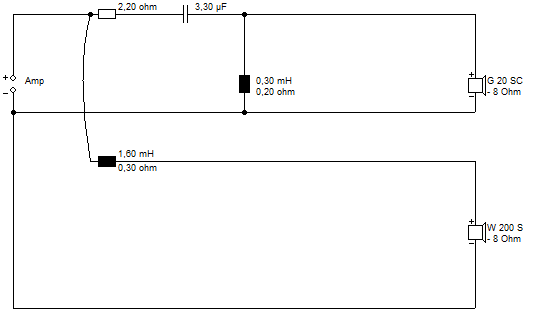
To this:
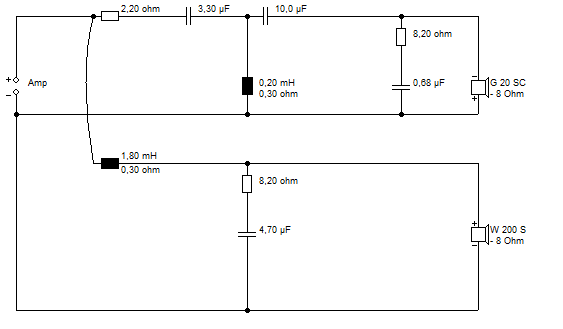
A 10uF or 6.8uF ought to do the right thing. -1dB Level adjustment would be best done by adding an ohm or so to the tweeter input. None of this stuff is very critical. I wouldn't worry about the exact coil vale.
The 27TBC/G and 27TBFC are almost identical. Personally I'd lose the ferrofluid:
Sonics by Joachim Gerhard cabinets and kits.
Sounds better IMO.

Change this:
To this:
A 10uF or 6.8uF ought to do the right thing. -1dB Level adjustment would be best done by adding an ohm or so to the tweeter input. None of this stuff is very critical. I wouldn't worry about the exact coil vale.
The 27TBC/G and 27TBFC are almost identical. Personally I'd lose the ferrofluid:
Sonics by Joachim Gerhard cabinets and kits.
Sounds better IMO.
...You're saying i should get some files of music that i know well and use a software equaliser to alter it's frequency characteristics...
...I decided to try using my tablet with the same app as before to see what difference that made. My reasoning being that the only thing that should really vary between the tablet and phone is the mic itself (it's trivially easy to make flat response electronics). Interestingly, the tablet shows none of the rising frequency response that the phone did....
I was groping for a way to create recordings useful for ear testing in the presence of hostility to REW room testing. So it is easy to take a woman singer and, for example, pump up 3-6kHz by 6 dB and see if that sounds better than the unpumped-up version. Etc.
Always encouraging people to make-do with whatever "test" gear they have, I've posted laptop REW curves compared to calibrated mic. Above maybe 200 Hz, not much difference. Also, if you work iteratively with EQ, the base plot is not an arbitrary benchmark to compare to your tunings.
BTW, any competent phone manufacturer would tailor their mic to voice band intelligibility only. But I bet the folks who make SPL apps for phones could reveal the correction they use.
B.
Is there any part number on the original Seas tweeter? Like the H1212 on the new 27TBFC/G. Some speaker makers use drivers whose only customization is a logo on the faceplate...So having done a bit of reasearch and finding that MA use modified SEAS tweeters
Ralf
- Home
- Loudspeakers
- Multi-Way
- Tweeter attenuation help
